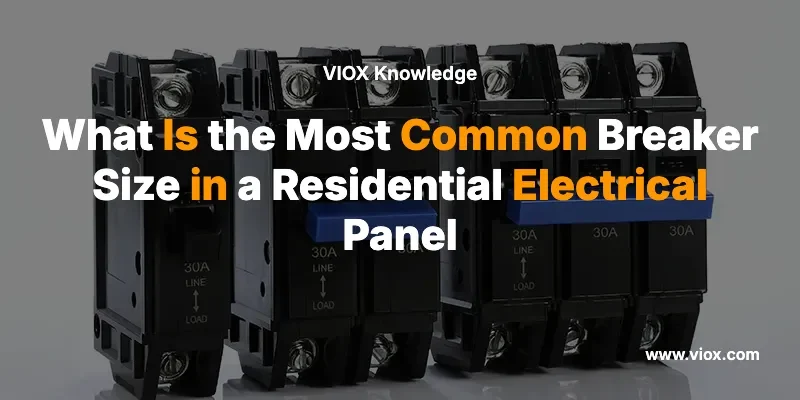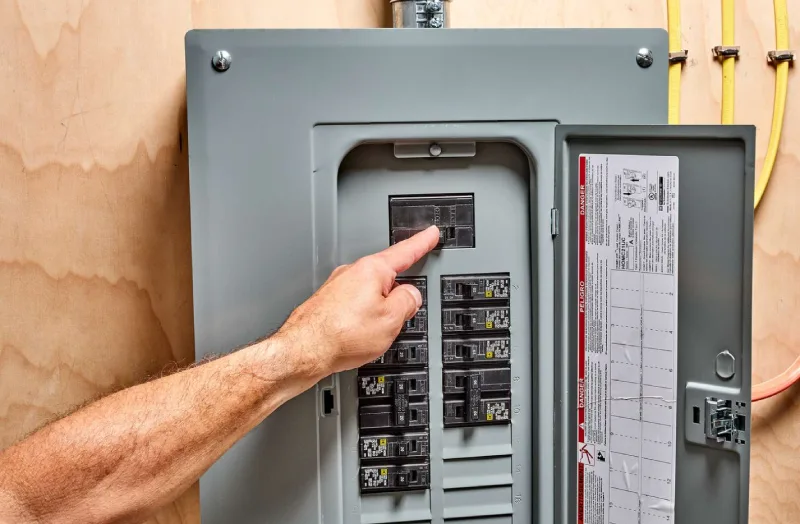빠른 응답: 주거용 전기 패널에서 가장 일반적인 차단기 크기는 다음과 같습니다. 15 암페어, 그 다음으로 20암페어 차단기가 뒤따릅니다. 이 두 가지 크기의 차단기는 일반적으로 표준 가정용 전기 패널의 모든 차단기의 60~70%를 차지하며, 15암페어 차단기는 일반 조명 회로를 보호하고 20 암페어 주방 콘센트, 욕실 및 기타 수요가 많은 구역에 전기를 공급하는 차단기입니다.
주거용 회로 차단기 기본 사항 이해

회로 차단기 집 전기 시스템의 핵심 안전 장치 역할을 하며, 회로 과부하 시 자동으로 전원을 차단합니다. 차단기 규격을 이해하면 주택 소유자가 전기 설비 업그레이드, 문제 해결 및 안전 규정 준수에 대한 현명한 결정을 내리는 데 도움이 됩니다.
가정 안전을 위해 브레이커 크기가 중요한 이유
회로 차단기의 전류 정격은 차단기가 작동하기 전에 해당 회로에 안전하게 흐를 수 있는 전류량을 결정합니다. 크기가 맞지 않는 차단기를 사용하면 다음과 같은 문제가 발생할 수 있습니다.
- 화재 위험 과부하된 회로에서
- 장비 손상 전력 공급이 부족해서
- 규정 위반 주택 검사 중
- 보험금 청구 거부 전기 사고 후
표준 주거용 차단기 크기의 완전한 분석
15암페어 차단기: 가장 일반적인 선택
사용률: 주택용 차단기 35-40%
주요 응용 분야:
- 집 전체의 일반 조명 회로
- 침실 콘센트(AFCI 제외 구역)
- 거실 표준 콘센트
- 복도 및 옷장 조명
필요한 와이어 게이지: 14 AWG 구리선
최대 안전 하중: 12 암페어(정격 용량의 80%)
전문가 끝: 15암페어 차단기는 15암페어를 처리할 수 있지만, 국가 전기 규정(NEC)에서는 연속 부하가 차단기 정격의 80% 또는 15암페어 회로의 경우 12암페어를 초과해서는 안 된다고 권장합니다.
20 암페어 차단기: 다재다능한 일꾼
사용률: 주택용 차단기 25-30%
주요 응용 분야:
- 주방 카운터 콘센트(GFCI 보호)
- 욕실 콘센트 및 조명
- 세탁실 회로
- 차고 콘센트
- 야외 콘센트(GFCI 보호)
필요한 와이어 게이지: 12 AWG 구리선
최대 안전 하중: 16 암페어(정격 용량의 80%)
고전류 차단기: 특수 응용 분야
| 브레이커 크기 | 패널 비율 | 일반적인 애플리케이션 | 와이어 게이지 |
|---|---|---|---|
| 30 암페어 | 10-15% | 전기 건조기, 온수기 | 10AWG |
| 40 암페어 | 5-8% | 전기 레인지, 대형 AC 장치 | 8AWG |
| 50 암페어 | 3-5% | 전기 레인지, RV 콘센트 | 6AWG |
| 60+ 암페어 | 2-3% | 온수 욕조, 전기 자동차 충전기 | 4 AWG 이상 |
브레이커 크기 분포의 지역적 차이
현대 건설 트렌드(2020-2025)
최근 건축법규와 생활 방식의 변화로 인해 차단기 크기 선호도가 바뀌었습니다.
- 20A 회로 증가: 현대 주택은 일반적으로 장치 부하 증가를 위해 20A 이상의 회로를 사용합니다.
- AFCI 요구 사항: 아크 고장 회로 차단기는 이제 대부분의 15 및 20 암페어 침실 회로에 필수입니다.
- EV 준비: 신축 건물에는 종종 40~50 암페어 EV 충전 회로에 대한 조항이 포함됩니다.
오래된 주택 고려 사항(1990년 이전)
1990년 이전에 지어진 주택은 다른 분포를 가질 수 있습니다.
- 15 암페어 회로의 더 높은 비율: 오래된 주택은 15암페어 회로에 더 많이 의존했습니다.
- 주방 회로 감소: 오래된 주방에는 현대식 가전제품에 적합한 20암페어 회로가 부족할 수 있습니다.
- 패널 업그레이드 필요 사항: 많은 오래된 패널은 현재 전기 수요를 충족하기 위해 업데이트가 필요합니다.
패널 차단기 크기를 결정하는 방법
단계별 식별 프로세스
- 전기 패널 찾기 (보통 지하실, 차고 또는 다용도실)
- 패널 커버를 엽니다 조심스럽게 (확실하지 않으면 메인 차단기를 끄세요)
- 차단기 라벨 읽기 – 전류량은 각 차단기 핸들에 인쇄되어 있습니다.
- 인벤토리를 생성하세요 각 차단기 크기와 보호 회로 나열
- 회로 목적 확인 패널 일정 사용(가능한 경우)
패널 검사 시 안전 예방 조치
- 노출된 전선을 만지지 마십시오 또는 패널 내부의 금속 구성 요소
- 손전등을 사용하세요 검사할 때 천장 조명 대신
- 해당 지역을 건조하게 유지하세요 – 젖은 손이나 습한 환경에서는 패널을 검사하지 마십시오.
- 전문가에게 전화하세요 타는 냄새, 부식 또는 손상된 구성 요소가 발견되면
전기 패널 차단기를 업그레이드해야 하는 시기
전문가의 평가가 필요하다는 신호
즉각적인 위험 신호:
- 명확한 원인 없이 차단기가 자주 트립됩니다.
- 전기 패널에서 타는 냄새가 나요
- 대형 가전제품을 켜면 조명이 어두워집니다.
- 따뜻하거나 뜨거운 브레이커 핸들
- 브레이커에 눈에 띄는 부식이나 손상이 있음
용량 업그레이드 지표:
- 새로운 고수요 가전제품(에어컨, 전기자동차) 추가
- 추가 회로가 필요한 주방 또는 욕실 개조
- 확장된 전기 서비스가 필요한 주택 증축
- 가스제품에서 전기제품으로 전환
전문가 vs. DIY 고려 사항
다음의 경우 항상 면허가 있는 전기 기술자를 고용하세요:
- 새로운 차단기 또는 회로 설치
- 업그레이드 중 패널 용량
- 메인 브레이커와 관련된 모든 작업
- 전기 문제 해결
주택 소유자에게 친화적인 작업:
- 기존 회로 식별 및 레이블 지정
- 트립된 차단기 재설정
- 기본 전기 부하 계산
- 계약자 상담 전 전기 업그레이드 계획
차단기 교체 및 업그레이드 비용 고려 사항
전형적인 교체 비용(2025년 가격)
| 서비스 유형 | 비용 범위 | 가격에 영향을 미치는 요인 |
|---|---|---|
| 단일 차단기 교체 | $150-$300 | 차단기 유형, 접근성, 지역 요금 |
| 다중 차단기 업그레이드 | $500-$1,200 | 회로 수, 전선 교체 필요 |
| 패널 용량 업그레이드 | $1,500-$4,000 | 현재 패널 상태, 전기 서비스 규모 |
| 패널 전체 교체 | $2,000-$6,000 | 주택 크기, 복잡성, 지역 허가 비용 |
프로젝트 비용을 증가시키는 요인
- 오래된 집의 배선: 새로운 회로로 광범위한 재배선이 필요할 수 있습니다.
- 코드 준수 업데이트: 기존 설비를 최신 NEC 표준에 맞춰 업그레이드
- 허가 요구 사항: 지방 허가 및 검사로 인해 시간과 비용이 추가됩니다.
- 접근 과제: 접근하기 어려운 패널은 인건비를 증가시킵니다.
주거용 차단기 크기에 대한 자주 묻는 질문
15암페어 차단기를 20암페어 차단기로 교체할 수 있나요?
아니요, 이건 위험하고 규정을 위반하는 일이에요. 차단기 크기는 회로의 전선 굵기와 일치해야 합니다. 굵기가 작은 전선에 큰 차단기를 설치하면 차단기가 작동하기 전에 전선이 과열되어 화재 위험이 있습니다.
일부 회로에서는 20암페어 대신 15암페어 차단기를 사용하는 이유는 무엇입니까?
비용과 필요성. 14개의 15개 암페어 회로 AWG 12 AWG 전선이 필요한 20A 회로보다 설치 비용이 저렴합니다. 조명 및 저전력 소비 콘센트 회로의 경우, 15A는 설치 비용을 절감하면서 적절한 용량을 제공합니다.
15암페어 회로에는 몇 개의 콘센트를 설치할 수 있나요?
일반적으로 8~10개의 콘센트, 하지만 실제 허용 한도는 콘센트 개수가 아니라 예상 전기 부하에 따라 달라집니다. 침실은 15암페어 회로에서 최대 10개의 콘센트를 사용할 수 있지만, 홈 오피스는 컴퓨터 장비로 인해 최대 6개의 콘센트만 사용할 수 있습니다.
최근 주택의 차단기 크기 분포가 다릅니까?
네, 상당히 그렇죠. 2010년 이후에 지어진 주택은 현대식 장치, 가전제품, 주방 및 욕실 회로에 대한 규정으로 인해 전기 수요가 증가하여 일반적으로 20암페어 이상의 회로를 사용합니다.
단극 차단기와 쌍극 차단기의 차이점은 무엇입니까?
전압 및 응용 분야. 단극 차단기(15, 20, 30 암페어)는 120V 회로에 전원을 공급하고, 2극 차단기(일반적으로 30+ 암페어)는 건조기, 레인지, 에어컨과 같은 대형 가전제품의 240V 회로에 전원을 공급합니다.
전기 미래 계획: 스마트 브레이커 전략
현대 전기 수요에 대비하기
오늘날의 주택은 그 어느 때보다 더 많은 전기 용량을 필요로 합니다. 전기 설비 업그레이드를 계획할 때 다음과 같은 추세를 고려하세요.
- 스마트 홈 통합:
- 장치 충전소를 위한 추가 20A 회로
- 스마트 홈 허브 및 네트워크 장비를 위한 전용 회로
- 스마트 스위치 및 디머를 위한 업그레이드된 조명 회로
- 전기 자동차 준비:
- 레벨 2 EV 충전을 위한 40~50A 회로
- 추가 부하를 처리하기 위해 업그레이드된 메인 패널 용량
- 여러 EV 충전소에 대한 미래 지향적 설계
- 에너지 효율 업그레이드:
- 30~60A 회로가 필요한 히트펌프 시스템
- 태양광 패널 인버터 회로(일반적으로 30~50 암페어)
- 전용 고전류 회로가 필요한 배터리 백업 시스템
결론: 전기 패널에 대한 정보에 입각한 결정 내리기
15암페어와 20암페어 차단기가 주택용 전기 패널의 대부분을 차지한다는 점을 이해하면 주택 소유자가 전기 시스템에 대한 현명한 결정을 내리는 데 도움이 됩니다. 일반 조명 및 콘센트 회로에는 여전히 15암페어 차단기가 가장 많이 사용되지만, 20암페어 회로로의 전환 추세는 현대 주택의 전기 수요 증가를 반영합니다.





